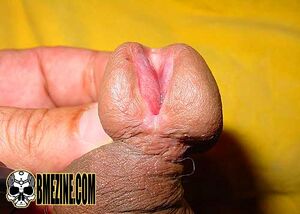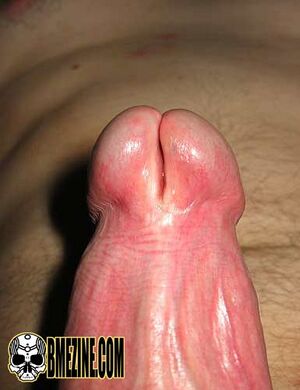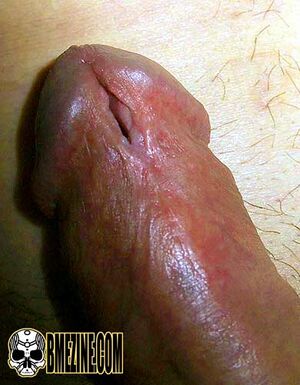|
|
| Line 1: |
Line 1: |
| <html><div class="mw-content-ltr" dir="ltr" id="mw-content-text" lang="en"><p><i><b>Warning: Having this document hopefully will make people think a bit harder about what they're doing so they can make the safest possible decision. In addition, it is BME's belief that, ultimately, a person has total authority over their body, and, given a sound mind, they have every right to pursue any body modification dreams they may have.</b></i>
| | '''Meatotomy''' is incision into and enlargement of a meatus. When the subincision is only underneath the glans it is known as a meatotomy (or, if naturally occurring, a [[Hypospadia|hypospadia]]). A meatotomy may occurs when a PA is torn out accidentally, but is usually done voluntarily as a [[Clamp and Cut|clamp and cut]] procedure in order to open the [[Urethra|urethra]], often for [[Sounding|sounding]] play. |
| </p><p>A <b>DIY Piercing</b> is a piercing that a person has done on themselves. There are a thousand reasons a person might not want to go to a professional. Their state might not allow piercing, or they might be below the legal age required. There might not be any qualified piercers in their area, or they might be uncomfortable having someone else invade their space in this way. They might want to do the piercing in a sexual context, or they might simply not be able to afford going to a piercer. The validity of these reasons is, of course, debatable, but the point is that many people do not want to go to a piercing studio to get their piercing, and they have that right.
| |
| </p>
| |
| <table class="toc" id="toc"><tr><td><div id="toctitle"><h2>Contents</h2></div>
| |
| <ul>
| |
| <li class="toclevel-1 tocsection-1"><a href="#Tools"><span class="tocnumber">1</span> <span class="toctext">Tools</span></a>
| |
| <ul>
| |
| <li class="toclevel-2 tocsection-2"><a href="#Piercing_Guns"><span class="tocnumber">1.1</span> <span class="toctext">Piercing Guns</span></a></li>
| |
| <li class="toclevel-2 tocsection-3"><a href="#Needles"><span class="tocnumber">1.2</span> <span class="toctext">Needles</span></a></li>
| |
| <li class="toclevel-2 tocsection-4"><a href="#Jewelry"><span class="tocnumber">1.3</span> <span class="toctext">Jewelry</span></a></li>
| |
| <li class="toclevel-2 tocsection-5"><a href="#Cheap_jewelry"><span class="tocnumber">1.4</span> <span class="toctext">Cheap jewelry</span></a>
| |
| <ul>
| |
| <li class="toclevel-3 tocsection-6"><a href="#Good_Jewelry"><span class="tocnumber">1.4.1</span> <span class="toctext">Good Jewelry</span></a></li>
| |
| <li class="toclevel-3 tocsection-7"><a href="#Make_your_own"><span class="tocnumber">1.4.2</span> <span class="toctext">Make your own</span></a></li>
| |
| <li class="toclevel-3 tocsection-8"><a href="#Using_Found_objects"><span class="tocnumber">1.4.3</span> <span class="toctext">Using Found objects</span></a>
| |
| <ul>
| |
| <li class="toclevel-4 tocsection-9"><a href="#Safety_pins"><span class="tocnumber">1.4.3.1</span> <span class="toctext">Safety pins</span></a></li>
| |
| <li class="toclevel-4 tocsection-10"><a href="#Old_Earrings"><span class="tocnumber">1.4.3.2</span> <span class="toctext">Old Earrings</span></a></li>
| |
| </ul>
| |
| </li>
| |
| </ul>
| |
| </li>
| |
| </ul>
| |
| </li>
| |
| <li class="toclevel-1 tocsection-11"><a href="#Sterilization"><span class="tocnumber">2</span> <span class="toctext">Sterilization</span></a>
| |
| <ul>
| |
| <li class="toclevel-2 tocsection-12"><a href="#New_Jewelry"><span class="tocnumber">2.1</span> <span class="toctext">New Jewelry</span></a></li>
| |
| <li class="toclevel-2 tocsection-13"><a href="#Tools_2"><span class="tocnumber">2.2</span> <span class="toctext">Tools</span></a></li>
| |
| <li class="toclevel-2 tocsection-14"><a href="#Workspace"><span class="tocnumber">2.3</span> <span class="toctext">Workspace</span></a></li>
| |
| <li class="toclevel-2 tocsection-15"><a href="#Rubber_Gloves"><span class="tocnumber">2.4</span> <span class="toctext">Rubber Gloves</span></a></li>
| |
| <li class="toclevel-2 tocsection-16"><a href="#Cross_Contamination"><span class="tocnumber">2.5</span> <span class="toctext">Cross Contamination</span></a></li>
| |
| <li class="toclevel-2 tocsection-17"><a href="#Dispose_of_Needle"><span class="tocnumber">2.6</span> <span class="toctext">Dispose of Needle</span></a></li>
| |
| </ul>
| |
| </li>
| |
| <li class="toclevel-1 tocsection-18"><a href="#Procedure"><span class="tocnumber">3</span> <span class="toctext">Procedure</span></a></li>
| |
| <li class="toclevel-1 tocsection-19"><a href="#So_now_you.27re_a_piercer.3F"><span class="tocnumber">4</span> <span class="toctext">So now you're a piercer?</span></a>
| |
| <ul>
| |
| <li class="toclevel-2 tocsection-20"><a href="#Piercing_at_Home"><span class="tocnumber">4.1</span> <span class="toctext">Piercing at Home</span></a></li>
| |
| </ul>
| |
| </li>
| |
| <li class="toclevel-1 tocsection-21"><a href="#Legality"><span class="tocnumber">5</span> <span class="toctext">Legality</span></a></li>
| |
| <li class="toclevel-1 tocsection-22"><a href="#See_Also"><span class="tocnumber">6</span> <span class="toctext">See Also</span></a></li>
| |
| <li class="toclevel-1 tocsection-23"><a href="#External_Links"><span class="tocnumber">7</span> <span class="toctext">External Links</span></a></li>
| |
| </ul>
| |
| </td></tr></table>
| |
| <h2> <span class="mw-headline" id="Tools">Tools</span></h2>
| |
| <p>First of all, most home piercings can be done with nothing more than a needle and jewelry. The simpler your procedure, the less you need to worry about—and the less ways there are for something to go wrong.
| |
| </p><p>However, if you're piercing yourself regularly or in awkward spots, any first aid, sports medicine, or home care supply shop can sell you <a href="/index.php?title=Clamp" title="Clamp">clamps</a> (although these shops generally stock high-quality German tools which you will pay a premium for). <a class="new" href="/index.php?title=Pennington&action=edit&redlink=1" title="Pennington (page does not exist)">Penningtons</a> are the ones with the triangular heads, and Foerrsters are the ones with the oval heads. You can also buy these clamps from a multitude of online vendors including <a class="mw-redirect" href="/index.php?title=BMEshop.com" title="BMEshop.com">BMEshop.com</a>.
| |
| </p>
| |
| <h3> <span class="mw-headline" id="Piercing_Guns">Piercing Guns</span></h3>
| |
| <p>A <a class="mw-redirect" href="/index.php?title=Piercing_gun" title="Piercing gun">piercing gun</a> is not appropriate. Obviously, it can not be properly sterilized, but more importantly it is simply not accurate or appropriate for body piercings. The jewelry is inserted using blunt force trauma, and is often too short for the piercing, crushing (and killing) the tissue.
| |
| </p><p>There is no advantage to using a piercing gun, and many disadvantages. Avoid them.
| |
| </p>
| |
| <h3> <span class="mw-headline" id="Needles">Needles</span></h3>
| |
| <p>A hollow needle has proved itself to be an excellent (and non-traumatic) design, but the real reason people use hollow needles is that it makes follow-through (the insertion of the jewelry) a simple process. If you use something like a safety pin, you will be able to make a hole, but getting the jewelry into this hole will be needlessly complicated and will probably do peripheral damage to the piercing.
| |
| </p><p>Some piercing studios are willing to sell needles to the general public (typically at a huge markup), and most larger cities have a tattoo or piercing supply shop. You can also buy hypodermic needles and remove the hub, or you can buy catheter needles and do a reverse insertion. That said, probably the easiest way to get piercing needles is via an online vendor such as <a class="mw-redirect" href="/index.php?title=BMEshop.com" title="BMEshop.com">BMEshop.com</a> or any one of hundreds of suppliers.
| |
| </p>
| |
| <h3> <span class="mw-headline" id="Jewelry">Jewelry</span></h3>
| |
| <p>Our bodies are very good at attacking foreign substances. Overall, our bodies don't like being pierced and will do what they can to stop you. As such, it's important to use high-grade biocompatible materials that you body isn't going to try and reject like a splinter.
| |
| </p>
| |
| <h3> <span class="mw-headline" id="Cheap_jewelry">Cheap jewelry</span></h3>
| |
| <p>Cheap jewelry is easy to find online. It's not uncommon to see rings and barbells selling for only a few dollars. However, there's a reason this jewelry is so cheap. To generalize, it's been mass-manufactured (i.e. made by machine) to a far lower standard than high-quality hand-made jewelry. This is especially apparent on barbells or other threaded jewelry; threads are usually short, rough, and external. In addition, the jewelry is often made of slightly lower quality materials, increasing your chances of an <a href="/index.php?title=Allergic_Reaction" title="Allergic Reaction">allergic reaction</a>.
| |
| </p><p>All that said, most people can wear low-end jewelry with only the most minor complications.
| |
| </p>
| |
| <h4> <span class="mw-headline" id="Good_Jewelry">Good Jewelry</span></h4>
| |
| <p>Of course you can buy good jewelry at most piercing studios, but, if you are self-piercing, that may not be an option. Online vendors are your easiest options, but stick to reputable vendors selling high quality jewelry. Unfortunately, the easiest way to recognize high quality jewelry is by its matched high price. If this jewelry is going to be in you for any extended period of time though, the money is well spent.
| |
| </p>
| |
| <h4> <span class="mw-headline" id="Make_your_own">Make your own</span></h4>
| |
| <p>You can make your own jewelry, but it will take an investment in tools and supplies. To be perfectly honest, it would be cheaper to just buy. Don't consider making your own jewelry unless you're doing it because you enjoy it.
| |
| </p><p>To make body piercing jewelry you will need first of all access to high quality materials —even very slight deviations in the grade of stainless steel, for example, can have a monstrous effect on reactions. You'll need to be able to shape your jewelry, and properly finish it (that probably means a buffer and an ultrasonic). If you're making threaded jewelry, you'll probably need a lathe as well as experience working with miniature taps and dies.
| |
| </p><p>Nothing in body jewelry is outside of the range of someone with basic machining knowledge, and the pieces are so simple that the techniques for making them will be obvious to anyone capable of it. However, if you don't have these skills, not only will you be throwing your money and time away, but you'll likely produce substandard jewelry that will complicate the healing of your piercing.
| |
| </p><p>Finally, it should be noted that the market for piercing jewelry is already flooded, and attempting to start a new jewelry company at this point would be financial suicide.
| |
| </p>
| |
| <h4> <span class="mw-headline" id="Using_Found_objects">Using Found objects</span></h4>
| |
| <h5> <span class="mw-headline" id="Safety_pins">Safety pins</span></h5>
| |
| <p>Sure, using your piercing implement as the jewelry seems like a great idea because it eliminates the follow through, and insertion is very easy. However, the simple fact is that <a class="mw-redirect" href="/index.php?title=Safety_pins" title="Safety pins">safety pins</a> are not made of an appropriate material. They are not usually stainless steel, and I think it's safe to say they are never made of an implant-grade stainless steel or titanium. As such, your body will probably react, perhaps simply by the surrounding tissue inflaming or even the surrounding tissue bonding to the pin as it begins to rust and break down from the body's chemicals.
| |
| </p>
| |
| <h5> <span class="mw-headline" id="Old_Earrings">Old Earrings</span></h5>
| |
| <p>Generally no; ear piercing jewelry (i.e. the gold hoops and studs that the mall ear-piercing industry uses) are not designed to work in body piercings. They are usually the wrong size both in length and <a href="/index.php?title=Gauge" title="Gauge">gauge</a>, are often flimsy, and are often made of lower grade materials. It's strongly urged that you make the small investment of decent quality jewelry.
| |
| </p><p>Also, someone else's used jewelry should never be put in someone else's piercings unless it is "made new" again. That means that it should be fully cleaned, polished, and sterilized again—essentially going through its last step of manufacturing a second time. If you leave out this step, it is very easy to pass disease from person to person. Lots of shops will <a href="/index.php?title=Autoclave" title="Autoclave">autoclave</a> your jewelry for a nominal fee.
| |
| </p><p>Other than that, the only real concern with using someone else's jewelry is that you don't necessarily know where they got it or what the quality is. (And of course the "gross out" factor of wearing old jewelry ... would you wear a used condom if it had been cleaned out first?)
| |
| </p>
| |
| <h2> <span class="mw-headline" id="Sterilization">Sterilization</span></h2>
| |
| <p>Well, how important is not having an infectious terminal disease like AIDS or Hepatitis C? What's more important to you, being alive, or being dead? Death is the realistic worst case scenario.
| |
| </p>
| |
| <h3> <span class="mw-headline" id="New_Jewelry">New Jewelry</span></h3>
| |
| <p>In theory, new jewelry is not contaminated and could be put in after disinfection. Realistically, rubbing alcohol should be enough (remember though, if you put alcohol on acrylic you will break it), but ...
| |
| </p><p>While the above is true in a perfect world, there's nothing saying that the jewelry isn't seriously contaminated. For example, how do you know that the machinist who made the jewelry doesn't have Hepatitis C? How do you know that they didn't cut their hand the day they were making your jewelry? How do you know that some of that blood didn't get on your jewelry? The odds may be slim, but do you really want to take the chance?
| |
| </p>
| |
| <h3> <span class="mw-headline" id="Tools_2">Tools</span></h3>
| |
| <p>The odds of new tools being contaminated is probably less than the odds of new jewelry being contaminated, but you should always take into account that even though the odds are slim, it's definitely possible. Low level should be adequate if the tool has never been used on anyone (including you).
| |
| </p><p>Certain bacteria can encase themselves in a protein coat, forming a spore. This bacteria is then extremely difficult to kill and may resist autoclaving. As such, after the tools are used, if you plan on re-using them on yourself (or anyone else) clean them thoroughly.
| |
| </p><p>If the tools are being used on anyone other than you, they absolutely must be autoclaved or be subjected to a high-level chemical sterilization process. Always remember that while you do have the right to do stupid stuff to yourself and put your own life at risk, you don't have that right if it's someone else's life. If you work on a friend and something goes wrong, you can be held criminally liable, even if they agreed to the piercing.
| |
| </p>
| |
| <h3> <span class="mw-headline" id="Workspace">Workspace</span></h3>
| |
| <p>A 5% to 10% solution (one tablespoon of bleach to one cup of water) can also be to disinfect potentially contaminated hard surfaces and clean off blood. A 1% solution (one tablespoon of bleach to one quart of water) can be used for general cleaning. As with most chemical cleaning agents, discard it after 24 hours, as that's its effective lifetime.
| |
| </p><p>It is important to take this step because in an uncontrolled environment things will sink to the lowest common denominator. To generalize, your procedure will quickly become as dirty and contaminated as the most dirty thing you come in contact with during the procedure, even second-hand. For example, if you put your clamps down on a dirty counter, they are then totally dirty as well and will contaminate anything they come in contact with.
| |
| </p>
| |
| <h3> <span class="mw-headline" id="Rubber_Gloves">Rubber Gloves</span></h3>
| |
| <p>The single most effective way to reduce the amount of contamination in your procedure (but certainly not the only thing you'll need to do) is to wash your hands. Whether you wear gloves or not, you must wash your hands. As with using an autoclave, you have to do this step right though; interdigitate (wash between your fingers) and clean fully!
| |
| </p><p>As far as rubber (latex or nitrile generally) gloves, if you're just piercing yourself, you can probably get away without them, but by using gloves you give yourself much more control over cross-contamination issues.
| |
| </p>
| |
| <h3> <span class="mw-headline" id="Cross_Contamination">Cross Contamination</span></h3>
| |
| <p>If your hands are clean, and you touch something dirty, then your hands are dirty that's <a href="/index.php?title=Cross_Contamination" title="Cross Contamination">cross contamination</a>. Think of it as cooties. Cooties will spread to anything they touch. As such, if you touch something that has cooties, you'd better wash your hands (or change gloves if you're using gloves) before touching anything clean.
| |
| </p>
| |
| <h3> <span class="mw-headline" id="Dispose_of_Needle">Dispose of Needle</span></h3>
| |
| <p>Officially, it should be put into an approved <a href="/index.php?title=Sharps_Container" title="Sharps Container">sharps container</a> and disposed of as local laws require. Most hospitals can help you with that. It's certainly not recommended, but you could just put the needles in a hard pill bottle and ask a local hospital how you are required to dispose of it.
| |
| </p><p><i>Please don't just throw old needles in the garbage.</i> You have every right to pierce yourself and put yourself at risk, but you have no right to put others, including garbage men, at risk.
| |
| </p>
| |
| <h2> <span class="mw-headline" id="Procedure">Procedure</span></h2>
| |
| <p>You could simply push push the jewelry through the skin without a needle, but there's no good reason for doing this—why do extra damage when you don't need to? Ear piercing studs are sharp enough that if you really want to do this, you can. However, ear piercing studs are too short for pretty much anything other than ears. Ears are relatively resilient, so the additional trauma probably won't lead to problems, at least in lobes. However, cartilage is much more sensitive and it would not be in your best interests to mistreat your ears like this.
| |
| </p><p>While the vast majority of people can put an ice cube on their ear, use a carrot as a backing, and push a stud through without any real problems, it will increase the chance of complications for everyone. For those people who are sensitive to cartilage damage, using a method like this makes it far more likely that you'll have problems.
| |
| </p><p>Overall, this is one of those things where the answer is "yes ... but why?" There is no advantage to piercing like this, and many disadvantages.
| |
| </p>
| |
| <h2> <span class="mw-headline" id="So_now_you.27re_a_piercer.3F"> So now you're a piercer?</span></h2>
| |
| <h3> <span class="mw-headline" id="Piercing_at_Home">Piercing at Home</span></h3>
| |
| <p>You can't pierce your friends safely at home. Piercing others isn't the same as self-piercing since you are putting them at risk instead of you. Once you have multiple people involved, contamination risks rise dramatically.
| |
| </p><p>Setting up a studio at home where you can safely pierce your friends is a venture that requires at least a thousand dollar investment, if not far more. There is no way for you to reasonably do this. If you want to pierce your friends, become a piercer. The official answer is, and probably always will be, "DON'T DO IT."
| |
| </p>
| |
| <h2> <span class="mw-headline" id="Legality">Legality</span></h2>
| |
| <p>Realistically, piercing yourself is not illegal. However, if you present a profile that makes doctors (or your parents) believe that you are a danger either to yourself or to others, you might find yourself committed against your will. If you are also a cutter (i.e. if you scar yourself), you should keep this risk in mind.
| |
| </p><p>If you pierce someone else, depending on if your area has laws about piercing (age requirements, autoclave requirements, etc.) you will be required to meet these laws. If you don't, you can and will be charged. In addition, if something goes wrong during the procedure, you could be criminally charged with anything from simple assault on up to murder.
| |
| </p>
| |
| <h2> <span class="mw-headline" id="See_Also"> See Also </span></h2>
| |
| <ul><li> <a class="mw-redirect" href="/index.php?title=Self-piercing" title="Self-piercing">Self-piercing</a>
| |
| </li><li> <a href="/index.php?title=Sterilization" title="Sterilization">Sterilization</a>
| |
| </li><li> <a href="/index.php?title=DIY" title="DIY">DIY</a>
| |
| </li><li> <a href="/index.php?title=DIY_Surgical_Mods" title="DIY Surgical Mods">DIY Surgical Mods</a>
| |
| </li></ul>
| |
| <h2> <span class="mw-headline" id="External_Links">External Links</span></h2>
| |
| <ul><li> <a class="external text" href="http://www.bmezine.com/news/pubring/20021103.html" rel="nofollow">Why BME supports self-piercing</a>
| |
| </li></ul>
| |
|
| |
|
| | It should be noted that meatotomy procedures tend to have excessive [[Bleeding|bleeding]] and [[Infection|infection]] is also a minor risk. Meatotomies usually heal in a week and tend to be far less difficult to heal than a piercing. |
|
| |
|
| </div></html>
| | A meatotomy will have little effect for penetrative sex from either the meatotomized person's point of view or their partners, although it will improve manual stimulation for those that enjoy urethral stimulation. Anatomically, the urethra tightens immediately behind the glans, so this procedure can greatly improve access to the urethra for larger [[Sound|sounds]]. |
| | |
| | Meatotomies usually damage the ability to urinate normally because they disrupt the urine spray, although this is definitely not always the case. |
| | |
| | {| class="wikitable" style="text-align: center;" |
| | |- |
| | | [[File:Meatotomy-1.jpg|thumb|center|Meatotomy]] |
| | | [[File:Meatotomy-2.jpg|thumb|center|Meatotomy]] |
| | | [[File:Meatotomy-3.jpg|thumb|center|Meatotomy]] |
| | | [[File:Meatotomy-4.jpg|thumb|center|Meatotomy]] |
| | |} |



